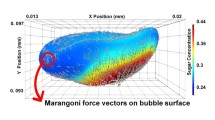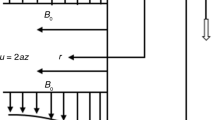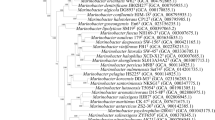Abstract
The effects of simulated microgravity on two bacterial isolates,Sphingobacterium thalpophilium andRalstonia pickettii (formerlyBurkholderia pickettii), originally recovered from water systems aboard the Mir space station were examined. These bacteria were inoculated into water, high and low concentrations of nutrient broth and subjected to simulated microgravity conditions.S. thalpophilium (which was motile and had flagella) showed no significant differences between simulated microgravity and the normal gravity control regardless of the method of enumeration and medium. In contrast, forR. pickettii (that was non-motile and lacked flagella), there were significantly higher numbers in high nutrient broth under simulated microgravity compared to normal gravity. Conversely, whenR. pikkettii was inoculated into water (i.e., starvation conditions) significantly lower numbers were found under simulated microgravity compared to normal gravity. Responses to microgravity depended on the strain used (e.g., the motile strain exhibited no response to microgravity, while the non-motile strain did), the method of enumeration, and the nutrient concentration of the medium. Under oligotrophic conditions, non-motile cells may remain in geostationary orbit and deplete nutrients in their vicinity, while in high nutrient medium, resources surrounding the cell may be sufficient so that high growth is observed until nutrients becoming limiting.
Similar content being viewed by others
References
Brown, R.B., Klaus, D., Todd, P.: Effects of space flight, clinorotation, and centrifugication on the substrate utilization efficiency ofE. coli. Microgravity Sci. Tech., vol. 13, p. 24 (2002).
Kacena, M.A., Merrell, G.A., Manfredi, B., Smith, E.E., Klaus, D. M. andTodd, P.: Bacterial growth in space flight: logistic growth curve parameters forEscherichia coli andBacillus subtilis. Appl. Environ. Microbiol., vol. 51, p. 229 (1999).
Kacena, M.A., Smith, E.E. andTodd, P.: Autolysis ofEscherichia coli andB. subtilis cells in low gravity. Appl. Microbiol. Biotechnol., vol. 52, p. 437 (1999).
Klaus, D., Simske, S., Todd, P. andStodieck, L.: Investigation of space flight effects onEscherichia coli and a proposed model of underlying physical mechanisms. Microbiol., vol. 143, p. 449 (1997).
Kacena, M.A., Manfredi, B. andTodd, P.: Effects of space flight and mixing on bacterial growth in low volume cultures. Microgravity Sci. Technol., vol. 12, p. 74 (1999).
Gasset, G., Tixador, R., Eche, B., Lapchine, L., Moatti, N., Toorop, P., Woldringh, C.: Growth and division ofEscherichia coli under microgravity conditions. Res. Microbiol., vol. 145, p. 111 (1994).
Goldermann, M., Hanke, W.: Ion channel are sensitive to gravity changes. Micrograv. Sci. Tech., vol. 13, p. 35 (2001).
Kacena, M. andTodd, P.: Growth characteristics ofE. coli andB. subtilis cultured on an agar substrate in microgravity. Micrograv. Sci. Technol., vol. 10, p. 58 (1997).
Takahashi, A., Ohnishi, K., Yokota, A., Kumagai, T., Nakano, T., Ohnishi, T.: Mutation frequency of plasmid DNA andEscherichia coli following long-term space flight on Mir. J. Radiation Res. (suppl.), vol. 43, p. S137 (2002).
Klaus, D.M.: Clinostats and bioreactors. Gravit. Space Biol. Bull., vol 14, p. 55 (2001).
Klaus, D.M., Todd, P., Schatz, A.: (1998) Functional weightlessness during clinorotation of cell suspensions. Adv. Space Res., vol. 21, p. 1315 (1998).
Erdmann, N., Effmert, U., Fulda, S., Oheim, S.: Effect of gravity changes on the cyanobacteriumSynechocystis sp. PCC 6803. Curr. Microbiol., vol. 35, p. 348 (1997).
Fang, A., Pierson, D.L., Koenig, D.W., Mishra, S.K., Demain, A.L.: Effect of simulated microgravity and shear stress on microcin B17 production byEscherichia coli and on its excretion into the medium. Appl. Environ. Microbiol., vol. 63, p. 4090 (1997).
Häder, D.-P., Rosum A., Schäfer, J., Hemmersbach, R.: Graviperception in the flagellateEuglena gracilis during a shuttle space flight. J. Biotechnol., vol. 47, p. 261 (1996).
Nickerson, C.A., Ott, C.M., Wilson, J.W., Ramamurthy, R., LeBlanc, C.L., Höner zu Bentrup, K., Hammond, T., Pierson, D.L.: Low-shear modeled microgravity: a global environmental regulatory signal affecting bacterial gene expression, physiology, and pathogenesis. J. Microbiol. Methods, vol. 54, p. 1 (2003).
Thiruvenkatam, R., Scholz, C.: Synthesis of poly (ß-hydroxybutyrate) in simulated microgravity: an investigation of aeration profiles in shake flask and bioreactor. J. Polym. Environ., vol. 8, p. 155 (2000).
Wilson, J.W., Ott, C.M., Ramamurthy, R., Porwollik, S., McClelland, M., Pierson, D.L. andNickerson, C.A.: Low-shear modeled microgravity alters theSalmonella enterica sevovar typhimurium stress response in an Rpo-S independent manner. Appl. Environ. Microbiol., vol. 68, p. 5408 (2002).
Gu, J.-D., Roman, M., Esselman, T., Mitchell, R.: The role of microbial biofilms in deterioration of space station candidate materials. Int. Biodeter. Biodegrad., vol. 41, p. 25 (1998).
Pierson, D.L.: Microbial contamination of spacecraft. Gravit. Space Biol. Bull., vol. 14, p. 1 (2001).
Boulos, L., M. Prévost, B. Barbeau, J. Coallier, R. Desjardins.:LIVE/DEAD®BacLight: application of a new rapid staining method for direct enumeration of viable and total bacteria in drinking water. J Microbiol. Methods vol. 37, p. 77 (1999).
Porter, K. G., Y.S. Feig, Y.S.: The use of DAPI for identification and counting of aquatic microflora. Limnol. Oceanogr., vol. 25, p. 943 (1980).
Lemke, M.J., McNamara, C.J., Leff, L.G.: Comparison of methods for concentration of bacterioplankton for in situ hybridization. J. Microbiol. Methods, vol. 29, p. 23 (1997).
Amann, R.I., Ludwig, W., Schleifer, K.-H.: Phylogenetic identification and in situ detection of individual microbial cells without cultivation. Microbiol. Rev., vol. 59, p. 143 (1995).
Author information
Authors and Affiliations
Corresponding author
Rights and permissions
About this article
Cite this article
Baker, P.W., Leff, L. The effect of simulated microgravity on bacteria from the mir space station. Microgravity Sci. Technol 15, 35–41 (2004). https://doi.org/10.1007/BF02870950
Received:
Revised:
Accepted:
Issue Date:
DOI: https://doi.org/10.1007/BF02870950




